How Long Does it Take for a Tattoo to Heal?
How long does it take for a scar camouflage Tattoo to Heal?
Here we will learn more about the camouflage tattoo healing process.
Article includes progress pictures of camouflage tattoo healing stages.
Specialized tattoo artists have created a form of tattooing known by many names, i.e., camouflage micropigmentation, camouflage tattoo, and paramedical tattoo. All are used to help camouflage skin imperfections and help restore confidence.
A paramedical tattoo usually heals in two to four weeks, but this time frame can vary depending on several factors.
While complete recovery may take several months, initial symptoms should disappear within a few weeks.
Patients must adhere to post-tattoo care instructions during this time, staying away from or cutting back on anything that could hinder their healing. Camouflage Micropigmentation can take a while to heal, and this article will go over some of the variables that can affect that time. We’ll help you out with the aftermath, too.
Tattoo healing process and everything you should know about it.
The time required for a paramedical tattoo to properly heal drastically between individuals and tattoos. Most sources indicate that tattoos take roughly two weeks to heal.
Yet, the skin’s full recovery could take up to four weeks. Because of potential complications, recovery time could be extended.
What follows is a general description of what one can anticipate.
Healing tattoo stages pictures and More
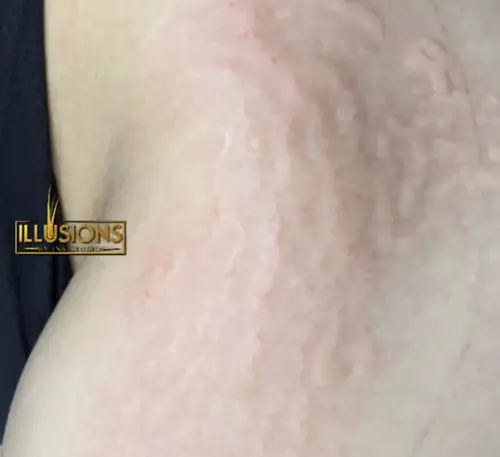
THIS PHOTO SHOWS WHAT YOUR CAMOUFLAGE MAY LOOK LIKE IMMEDIATELY POST-TATTOO
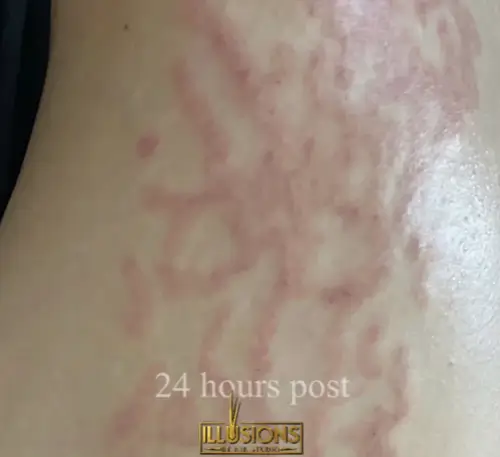
THIS PICTURE SHOWS WHAT YOUR CAMOUFLAGE TATTOO MAY LOOK LIKE 24 HOURS POST-TATTOO
Day 1
After getting their paramedical tattoos, most people leave the camouflage tattoo studio with their fresh camouflage micropigmentation covered with a breathable bandage. Your paramedical tattooist will tell you how soon you can remove the dressing after getting inked.
Excess ink and a clear liquid can be seen oozing from the tattoo, but both are entirely normal. Itching, warmth, and slight redness of the skin are also possible.
To ensure that a camouflage tattoo heals properly, clients should first wash their hands, gently wash the tattoo with fragrance-free antimicrobial soap, and finally, apply a water-based moisturizer.
One Week
The tattoo should feel less tender and red after the first few days. As time passes, a camouflage tattoo’s color will change colors, turning a variation darker shade and eventually lightening up to match the surrounding tissue. This is normal and indicates that the tattoo is healing.
The appearance of scabbing is a normal part of the skin’s recovery process. Scarring can result from picking at scabs, so it’s best to leave them alone. Itching of the skin is another common symptom at this point. On the other hand, refrain from scratching it.
Peeling is a typical element of the healing process because it enables the skin to shed damaged cells. This can occur a few days after receiving a tattoo, as the skin exfoliates and produces new cells.
When people wash their camouflage micropigmentation tattoos, they may notice peeling or flaking skin. They should keep washing with an antimicrobial soap and moisturize the tattoo 1-2 times daily.
Allergic responses to tattoo ink are most prevalent in the initial few days and weeks. Red, blue, and green tattoo inks carry a greater chance of causing an allergic reaction. During this period, potential illnesses are also most prone to occur.
Although allergic reactions to tattoos are extremely rare, it is never a bad idea to ask your paramedical tattoo artist for a test patch before committing to a full-fledged camouflage tattoo.
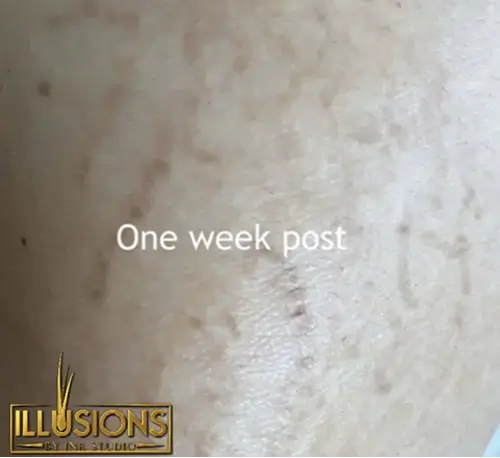
THIS PHOTO SHOWS WHAT YOUR CAMOUFLAGE TATTOO MAY LOOK LIKE ONE-WEEK POST-TATTOO.
The initial days and weeks
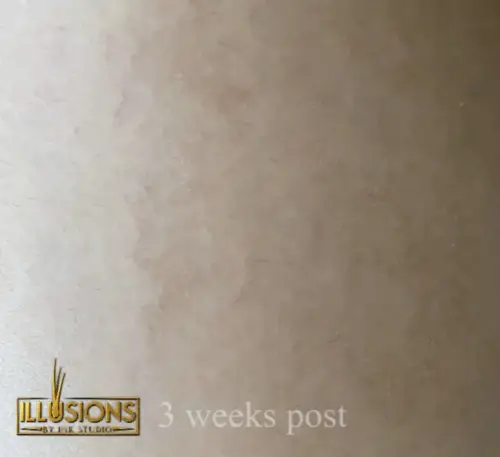
THIS PHOTO SHOWS WHAT YOUR CAMOUFLAGE TATTOO MAY LOOK LIKE THREE WEEKS POST.
Week 2
As the scabs harden, they sometimes fall off on their own. It’s still crucial that you don’t pick at the scabs, as doing so can irritate the ink underneath and cause scarring.
At this point, many tattoos should be nearly fully healed. People should experience less redness, swelling, and itching as a result.
The presence of pain and swelling, however, may be an indication of inflammation and infection in the tattoo. Anyone experiencing this should seek medical attention right away.
Between Weeks 3 and 4
At this point, the majority of the scabs and peeling skin should have disappeared.
If the skin feels dry, people should continue to moisturize it.
Because the outer layers of the skin regenerate the fastest, they should have healed completely. Deeper skin layers may take several months to heal.
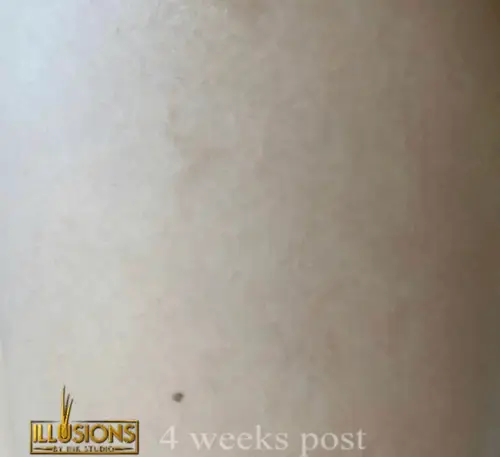
THIS PHOTO SHOWS WHAT YOUR CAMOUFLAGE TATTOO MAY LOOK LIKE FOUR WEEKS POST.
Possible Regenerative Factors?
Picking a reliable tattoo parlor that uses proper aseptic procedures is crucial.
Infections caused by lack of proper tattoo hygiene can significantly slow healing and even cause serious health problems.
For instance, the CDC’s earlier studies show the main factors and sources of infection are obtaining tattoos from unlicensed businesses and contaminated ink.
Research conducted in 2016 into the potential for infection from tattoos has found that anywhere from 0.5% to 6% of people will develop complications from their ink. Infection risk can be minimized by selecting a reputable camouflage tattoo or paramedical tattoo studio and strictly adhering to your camouflage tattoo aftercare instructions.
Choose a tattoo artist who is authorized to work in your state. Unfortunately, federal law does not govern tattoo licensing. However, the National Conference of State Legislatures publishes the requirements in individual states.
In addition to your paramedical tattoo artist’s skill, the quality of their techniques impacts how long it takes for the wound to heal.
Healing time may also be affected by the tattoo’s size and placement. Tattoos placed closer to joints or flexible areas, for instance, will take longer to heal than those placed in less mobile areas. Tattoos take longer to heal, depending on their size.
Tattoo healing time can also be affected by the competence of the tattoo artist and the ink color selected for the tattoo. It is known that red pigments are more likely to prompt hypersensitivity reactions and decelerate the healing process. Recovery of the dermal and epidermal layers of the skin may take several months.
When can you begin taking part in certain Activities?
New camouflage tattoos should be protected from direct sunlight to prevent darkening, scabbing, and slower wound healing. Sunlight contains ultraviolet (UV) radiation. While a tattoo is healing, the person should stay out of direct sunlight for a minimum of four weeks.
Infection is possible because a tattoo is an open wound. Tattoo artists advise their clients to avoid certain activities until the wound has healed or two weeks post-tattoo.
Exercising and other vigorous activities that cause perspiration and movement of the tattoo, as well as submerging the tattoo in the water while washing, bathing, or swimming, fall into this category.
People with fresh tattoos are at increased risk of contracting severe infections from the water.
Camouflage Tattoo After Care Tips
The following guidelines were developed by the American Academy of Dermatology and are recommended for optimal tattoo healing:
Apply a suitable moisturizer: If the tattoo and the skin around it are dry, a cream or lotion based on water is recommended we use and recommend Aquaphor. People should avoid using petroleum-based products because they accelerate the aging process.
The area that had camouflage micropigmentation should not be exposed to the sun. Prolonged sun exposure to your camouflage and paramedical tattoos will cause the areas to darken and extend healing time.
After two weeks, or when the tattoo is no longer an open wound, a broad-spectrum sunscreen with a minimum SPF of 30 should be applied. Apply it at least 15 minutes before heading outdoors, and reapply it every couple of hours.
Tanning beds should be avoided at all costs. The ink in tattoos can be darkened with the help of UV lamps and tanning beds. Additionally, they are linked to an increased risk of skin cancer. Some people experience excruciating pain when exposed to UV light on their tattooed skin.
The tattoo should be washed regularly using a fragrance-free, hypoallergenic, antibacterial soap. The use of a paper towel to gently pat the skin dry prior to applying a cream is also recommended.
When to seek medical attention?
After getting a camouflage tattoo, it’s normal to have some swelling and redness. However, if any of the following unusual symptoms occur, medical attention should be sought:
INFECTION
A tattoo that has become infected will be noticeably redder, more painful, and may even have pus or open sores. A person with a high temperature or chills should immediately see a doctor.
REACTION TO ALLERGENS
Someone can have an allergic reaction to their tattoo anytime, even years later. Medical attention is recommended if the tattooed area develops itching, redness, swelling, scaly patches, or lumps. Extreme reactions like trouble breathing, feeling faint, or a racing heart requires immediate medical attention.
DISORDER OF THE SKIN
Tattoos have been linked to an increased risk of developing or aggravating preexisting skin conditions like psoriasis and eczema. The skin is the body’s largest organ, so if there are any changes or irritations, it’s important to see a doctor.
It takes about two to four weeks for a tattoo to heal fully. People must pay close attention to aftercare instructions during this period to ensure the tattoo heals properly and no complications arise. Infection or excessive inflammation at the tattoo site can delay the healing process. Ask a doctor if you’re worried about how your tattoo is healing.
SCAR CAMOUFLAGE TATTOOING NEAR ME
Suppose you are in Texas and searching for a reputable scar camouflage tattoo near you. Come see us at Illusions by Ink Studio. We’ve had the opportunity to scar camouflage our neighbors in Houston, Dallas, Ft. Worth, and many surrounding areas.
4835 N O’Connor Rd, Suite 120
Irving, Texas 75062
